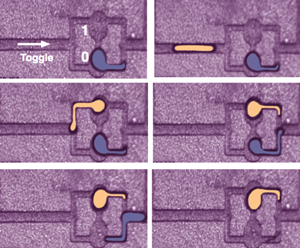The boundary between computing and chemistry has been redrawn, thanks to devices that mimic digital processors using the physical properties of flowing liquids and bubbles. The development opens the way for programmable lab-on-a-chip technologies without external control systems, claim the researchers.
In these devices the 'bits' (the zeroes and ones of binary language) are tiny gas bubbles in a stream of liquid flowing through precisely designed channels a few micrometres across.
The microfluidic systems represent 'a new digital logic family' said graduate student Manu Prakash, who developed the devices along with his supervisor Neil Gershenfeld at Massachusetts Institute of Technology, Cambridge, US. The bubbles can perform all the logic operations required for universal computation, including gates, memory, amplification and oscillation. They can even correct their own errors.
The bubble logic devices are not about to replace common computer components, as they compute about 1000 times slower than silicon. But Prakesh says the devices operate 100 times faster than the external controls used in existing microfluidic chips, allowing for a powerful combination of logic and chemistry. Each bubble bit can carry a payload of chemicals. Prakash and Gershenfeld, whose work is published today in Science, envisage highly complex microfluidic systems in which thousands of reagents could be stored in chemical memory. Bubble logic circuits could then mix and deliver them to specific destinations.
Fluid dynamics provides the physical basis for the logic. When a bubble reaches a junction in the channel it will choose the path of least resistance. If one of the channels already has a bubble in it this creates resistance to the flow and the next bubble will take an alternative path. In this way, the logic is determined by the channel geometry. 'Once we had the physics pinned down, the design falls out pretty easily' Prakash told Chemistry World.

Bubble toggle memory: In the stream flowing left-to-right, a 'toggle signal' (pink bubble) enters, and takes up the '1' position, forcing the blue bubble out of the '0' position. Effectively, one 'bit' of information (and a packet of material) is stored until another toggle signal arrives.
© Science
|
For Prakash, the most satisfying of the components he designed was a ring oscillator, consisting of three AND gates connected in a ring structure. This is a standard bench test in electronic logic to demonstrate feedback, or a signal acting on itself, which had never been demonstrated in microfluidics before now. 'This was very pleasing and very aesthetic' said Prakash.
Microfluidics researcher James Wilkinson, professor of electronics at the University of Southampton, UK, was excited by the findings. The researchers have come up with an 'elegant and powerful technique for a new generation of lab-on-a-chip where chemical species are rapidly processed digitally,' said Wilkinson. 'I believe that it has great potential.'
Tom Westgate




